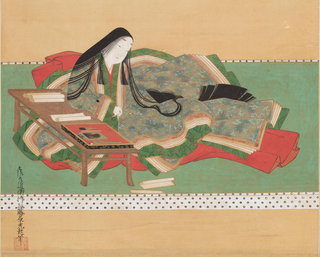
Murasaki Shikibu was a Japanese novelist, poet and lady-in-waiting at the Imperial court in the Heian period. She is best known as the author of The Tale of Genji, widely considered to be one of the world's first novels, written in Japanese between about 1000 and 1012. Murasaki Shikibu is a descriptive name; her personal name is unknown, but she may have been Fujiwara no Kaoruko (藤原香子), who was mentioned in a 1007 court diary as an imperial lady-in-waiting.

The Tale of Genji, also known as Genji Monogatari is a classic work of Japanese literature written by the noblewoman, poet, and lady-in-waiting Murasaki Shikibu around the peak of the Heian period, in the early 11th century. The original manuscript no longer exists. It was made in "concertina" or orihon style: several sheets of paper pasted together and folded alternately in one direction then the other.

Japanese literature throughout most of its history has been influenced by cultural contact with neighboring Asian literatures, most notably China and its literature. Early texts were often written in pure Classical Chinese or lit. 'Chinese writing', a Chinese-Japanese creole language. Indian literature also had an influence through the spread of Buddhism in Japan.

Natsuko Higuchi, known by her pen name Higuchi Ichiyō, was a Japanese writer during the Meiji era. She was Japan's first professional female writer of modern literature, specialising in short stories and poetry, and was also an extensive diarist. Her portrait appears on the 5000 yen banknote in Japan.
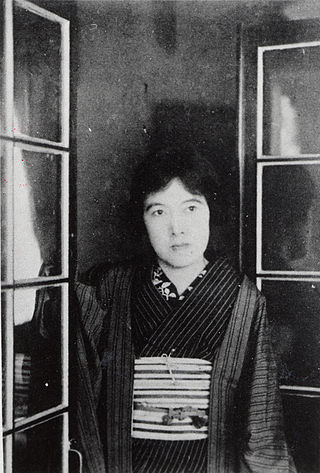
Yosano Akiko was the pen-name of a Japanese author, poet, pioneering feminist, pacifist, and social reformer, active in the late Meiji era as well as the Taishō and early Shōwa eras of Japan. Her name at birth was Shō Hō. She is one of the most noted, and most controversial, post-classical female poets of Japan.
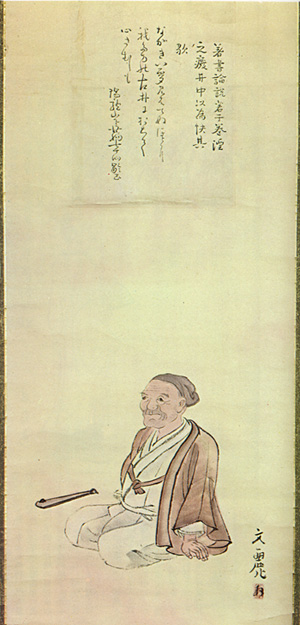
Ueda Akinari or Ueda Shūsei was a Japanese author, scholar and waka poet, and a prominent literary figure in 18th-century Japan. He was an early writer in the yomihon genre and his two masterpieces, Ugetsu Monogatari and Harusame Monogatari, are central to the canon of Japanese literature.

The Tale of the Bamboo Cutter is a monogatari containing elements of Japanese folklore. Written by an unknown author in the late 9th or early 10th century during the Heian period, it is considered the oldest surviving work in the monogatari form.

The Diary of Lady Murasaki is the title given to a collection of diary fragments written by the 11th-century Japanese Heian era lady-in-waiting and writer Murasaki Shikibu. It is written in kana, then a newly-developed writing system for vernacular Japanese, more common among women, who were generally unschooled in Chinese. Unlike modern diaries or journals, 10th-century Heian diaries tend to emphasize important events more than ordinary day-to-day life and do not follow a strict chronological order. The work includes vignettes, waka poems, and an epistolary section written in the form of a long letter.

Fumiko Hayashi was a Japanese writer of novels, short stories and poetry, who has repeatedly been included in the feminist literature canon. Among her best-known works are Diary of a Vagabond, Late Chrysanthemum and Floating Clouds.

Jakucho Setouchi, formerly known as Harumi Setouchi, was a Japanese Buddhist nun, writer, and activist. Setouchi wrote a best-selling translation of The Tale of Genji and over 400 fictional biographical and historical novels. In 1997, she was honoured as a Person of Cultural Merit, and in 2006, she was awarded the Order of Culture of Japan.
Kaoru is a fictional character in The Tale of Genji. He only appears as the lead for the novel's third act, called the 'Uji Jujo'. Kaoru has been called the first anti-hero in literature and is known for always having a strange but pleasant smell around him. He is known to be comparatively calculated and calm, and somewhat of an overthinker, as opposed to his love rival and close friend, Niou, who happens to be more "passionate" than he is.

Yuasa Yoshiko was a Russian language scholar and translator of Russian literature in Shōwa period Japan.
Eiga Monogatari is a Japanese monogatari that relates events in the life of the imperial courtier Fujiwara no Michinaga. It is believed to have been written by a number of authors between 1028 and 1107. It is notable for giving considerable credit to the Fujiwara family, especially Michinaga. It was translated into English by William H. and Helen Craig McCullough in 1980 as A Tale of Flowering Fortunes. It forms the basis for, and is frequently referenced. in Fumiko Enchi's retelling, A Tale of False Fortunes.

Ugetsu Monogatari is a collection of nine supernatural tales first published in 1776. It is the best known work of Japanese author Ueda Akinari.

Torikaebaya Monogatari, translated into English as The Changelings, is a Japanese tale from the late Heian period by an unknown author, or possibly more than one author. It is four volumes in length.
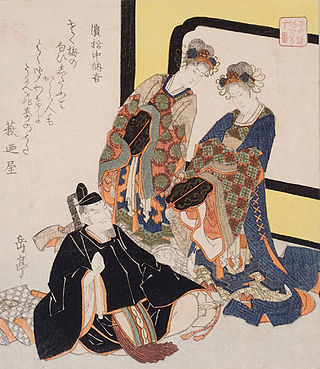
Hamamatsu Chūnagon Monogatari (浜松中納言物語), also known as Mitsu no Hamamatsu (御津の浜松), is an eleventh-century Japanese monogatari that tells about a chūnagon who discovers that his father has been reborn as a Chinese prince. He visits his reincarnated father in China and falls in love with the Hoyang Consort, consort of the Chinese Emperor and mother of his reborn father. The book originally comprised six chapters, but the first chapter has been lost.
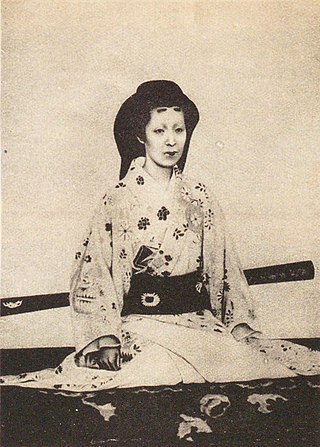
Hikimayu (引眉) was the practice of removing the natural eyebrows and painting smudge-like eyebrows on the forehead in pre-modern Japan, particularly in the Heian period (794–1185).
Masks is a novel by Japanese author Fumiko Enchi, published in 1958, however, an English translation by Juliet Winters Carpenter was published in 1983. Each of the novel's three sections takes its name from a type of Noh mask. Many elements of the novel were influenced by The Tale of Genji, which Enchi had earlier translated into modern Japanese.

Sumie Tanaka was a Japanese screenwriter and playwright with a feminist agenda. She was a long-time collaborator of film director Mikio Naruse and wrote screenplays for Japan's first major female director Kinuyo Tanaka. A member of the Bungakuza theatre company, she was married to dramatist Chikao Tanaka. Awards she received for her work include the Blue Ribbon Award, the Ministry of Education Award for Arts and the Yomiuri Prize for Literature.

Seiko Tanabe was a Japanese author. She graduated from the Department of Japanese Literature of Shōin Joshi Senmon Gakkō. Author of numerous novels, she won the Akutagawa Prize, Yomiuri Prize, and Asahi Prize, and received the Order of Culture for her contributions to literature. The honorific nicknamed the L. M. Montgomery of Japan after her death in 2019.



















